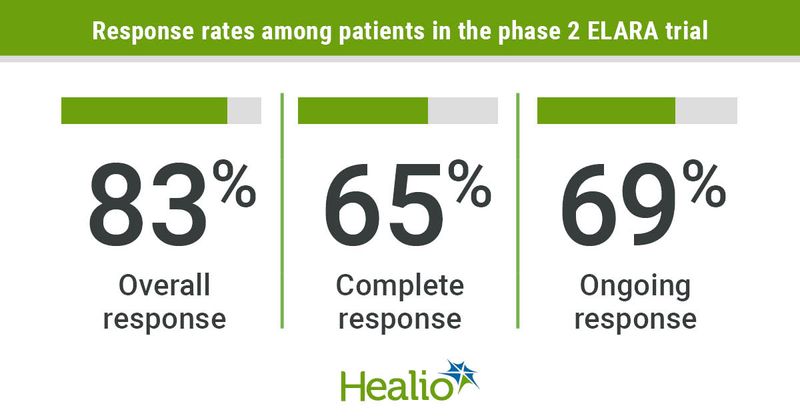CAR T-cell therapy ‘extremely effective’ for advanced follicular lymphoma, early data show
Sixty-five percent of patients with relapsed or refractory follicular lymphoma had an initial complete response to a single infusion of tisagenlecleucel, according to phase 2 study results presented at TCT Meetings Digital Experience.
These patients had a high probability (89.7%) of remaining in response for at least 6 months, and 69% of the first 52 patients evaluable for efficacy demonstrated ongoing responses as of data cutoff on May 26, 2020.

“Follicular lymphoma remains an incurable disease for nearly all patients,” Nathan H. Fowler, MD, professor of medicine in the department of lymphoma and myeloma at The University of Texas MD Anderson Cancer Center, said during a presentation.
Most patients with follicular lymphoma have a relapse-and-remitting pattern of disease, Fowler added.
“Each line of therapy is associated with shorter remission times, highlighting the need for newer therapies,” he added.
Previous studies of tisagenlecleucel (Kymriah, Novartis) among patients with lymphoma have shown “extremely high response rates,” according to Fowler.
“Preliminary data from this study suggest that tisagenlecleucel is extremely effective in patients with extensively pretreated and refractory follicular lymphoma,” he said.

Fowler and colleagues presented data from the single-arm, international ELARA trial, which evaluated the efficacy and safety of tisagenlecleucel — an autologous, CD19-directed chimeric antigen receptor T-cell therapy — among adults with relapsed or refractory follicular lymphoma.
The planned interim analysis presented during TCT included 97 patients (median age, 57 years; range, 29-73; 66% men; 24.7% aged 65 years or older), all of whom were evaluable for safety and 52 of whom were evaluable for efficacy.
“It’s important to note that most patients in this study had extensive prior therapy,” Fowler said.
Patients received a median four (range, 2-13) previous lines of therapy, with 77% refractory to their last line of therapy and 75% refractory to two or more lines of therapy.
Patients underwent lymphodepleting chemotherapy and received IV tisagenlecleucel at doses ranging from 0.6 × 108 CAR T cells to 6 × 108 CAR T cells (median, 2.06 × 108 CAR T cells). Fewer than half of patients (43.3%) received bridging therapy before infusion.
Complete response as determined by an independent review committee served as the study’s primary endpoint. Secondary endpoints include overall response rate, duration of response, PFS, OS and safety.
Median follow up was 9.9 months (range, 6-15.6) for efficacy and 6.5 months (range, 0.2-15.6) for safety.
The study met its primary endpoint, with a complete response rate of 65.4% (99.5% CI, 45.1-82.4). Researchers also reported a partial response rate of 17.3%, for an ORR of 82.7% (95% CI, 69.7-91.8).
ORRs appeared consistent across all subgroups analyzed, including those based on risk, disease status and prior hematopoietic stem cell transplant.
An “impressive” 44% of partial responders converted to complete response between 3 and 6 months after tisagenlecleucel infusion, Fowler said. Additionally, 69% of patients had an ongoing response to therapy as of the data cutoff point.
Median duration of response, PFS, and OS had not yet been reached. Researchers reported a 6-month PFS rate of 73.2% (95% CI, 58.2-83.5).
Nearly three-quarters (73.2%) of patients had treatment-related adverse events, the majority of which were hematologic in nature.
The most frequent grade 3 or greater treatment-related adverse events included neutropenia (24.7%), anemia (12.4%) and thrombocytopenia (8.2%).
Cytokine release syndrome occurred among nearly half (48.5%) of patients, with no cases of grade 3 or greater CRS. Median time to onset of CRS was 4 days (range, 1-14).
Nine percent of patients had neurotoxicity, including one grade 4 case of immune effector cell-associated neurotoxicity syndrome. Median time to onset of neurotoxicity was 8.5 days (range, 4-190).
All cases of CRS and neurotoxicity were resolved using standard management therapies. Three patients died during the study due to disease progression.
“The vast majority of patients are in remission and remain alive following treatment,” Fowler said, describing tisagenlecleucel’s safety profile as “favorable, particularly when compared with similar products.”
“This is a promising therapy for patients with relapsed or refractory follicular lymphoma, especially for patients who have had multiple prior lines of therapy,” he said.

